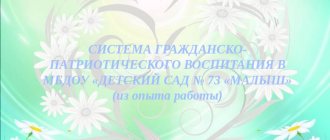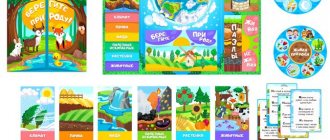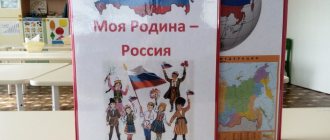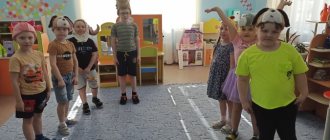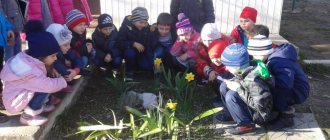Lapbook “My small Motherland, my Borovsky native”
Author:
Domnina Alina Mikhailovna
teacher
MADO Borovsky kindergarten "Zhuravushka"
Using a lapbook in working with preschoolers to form children’s primary ideas about their small homeland
Goal: Formation of primary ideas about the small homeland through the use of lapbooks in children of primary preschool age
Tasks:
- expand children’s knowledge about their native village of Borovsky: about the sights, monuments, objects located on the streets of the village; about the most significant enterprises of the village; nationalities living in the village;
— to cultivate love, respect and affection for one’s small Motherland;
-develop children’s cognitive interest, coherent speech, enrich and activate their vocabulary.
According to the Federal State Standard for Preschool Education, cognitive development involves the formation of preschoolers’ primary ideas about their small Motherland and Fatherland, and ideas about sociocultural values.
It is known that preschool age is the most important period in the formation of personality, when the prerequisites for civic qualities and patriotic feelings are laid, and although they are still elementary in their manifestations, they are extremely important for the further formation of personality. Love for the small Motherland begins with the attitude towards loved ones, towards the house, the street where the child lives, towards the kindergarten, towards the native village; with the assimilation of norms of behavior, familiarization with cultural values. After all, impressions about the place where a person grew up, about the history of his native land, received in childhood, remain for life.
Thus, the formation of primary ideas about the small Motherland among preschoolers is an urgent problem in the educational process of preschool educational institutions.
3 - 4 slide Every preschool teacher is always in search of new forms of organizing educational activities. In our work with children on the formation of primary ideas about their small Motherland, the result of such a search was a lapbook.
The laptop “My small Motherland, my Borovsky native” is a cube, on each face of which there are informative pockets. Inside the pockets there are didactic games and educational material about their native village. The pockets are attached to Velcro tape (“Velcro”), which allows children to use the pocket separately from the laptop and change pockets.
I would like to note that this type of laptop was not chosen by chance. It is made of a material that is easy to process, which is important nowadays.
The laptop meets all the requirements of the Federal State Educational Standard for Educational Education for a subject-spatial developmental environment:
- informative
- functional
- has didactic properties
- has a variable function (there are several options for using each part of it)
- provides playful, educational, research and creative activity for all pupils
- It helps the child organize information on the topic being studied at will.
- Children learn to independently collect information and use it.
- The laptop is well suited for individual and group lessons. Suitable for repeated use.
5-6 slide Pocket “Nationalities living in the village.” Goal: Formation and consolidation of knowledge about the multinationality of our village. Introduce national clothing. Instill interest in national culture. Development of color perception through the national costumes of peoples. Fostering respect for other nations.
The pocket contains cards depicting costumes of different nationalities: Tatars, Bashkirs, Kazakhs, Russians and Ukrainians. In order to arouse children's interest in studying the peoples living in our village, two types of pictures were made: the original version and for the game “Find a Pair”. Using the sample, and then without any prompts, you need to learn how to select a pair of national costumes.
Slide 7 Pocket “Sights, monuments of the native village.” Purpose: Expanding children’s knowledge about the sights, monuments, architectural buildings of the native village.
This pocket contains photographs of significant objects in the village of Borovsky.
Pupils can independently look at photographs of sights and monuments of the village of past years and see how they have changed and look like now.
When working with this material, preschoolers have the opportunity to compare, analyze, and talk about their favorite places. It should be noted that this pocket is constantly replenished with photographs from family albums, albums of grandparents, as well as photographs of favorite family vacation spots. Thus, children begin to get acquainted with the history of the village.
8 slide To motivate preschoolers, this pocket contains the game “Collect a picture.” Children are happy to collect the picture, at the same time remember and talk about the selected object.
9-10 slide Pocket “Dishes of different nationalities”. Goal: Formation of children's understanding of dishes of different types of national cuisine.
When studying the presented material, pupils get acquainted with their favorite dishes of different nationalities. Children look at pictures with images of certain dishes, learn the names of the dishes, and also have the opportunity to talk about their family’s favorite dish. In this pocket there is a game “Composition of a dish”: a picture is selected depicting a certain dish (to begin with, everyone knows), children need to select cards depicting the ingredients that are included in the selected dish. The game promotes the development of memory, attention, thinking, develops children's horizons and coherent speech.
11 – 12 slide Pocket “Professions of our parents, enterprises of the village.” Goal: Expanding and systematizing children’s knowledge about the world of professions using the example of the professions of their parents, as well as enterprises located in the village.
13 -14 slide Pocket “Folk folklore and traditions”. Goal: To develop children's interest in folk art, folklore, and traditions.
At the moment, in this pocket there are coloring cards depicting the nursery rhymes, rhymes and songs that we have studied. On the back of each card is a hint text for the teacher. Children can choose a card, remembering a familiar nursery rhyme, and color it as they wish. The cards are laminated, which allows them to be reused. This pocket is often replenished by parents who willingly share their knowledge of the nursery rhymes and songs that they use at home with their children. Thus, parents share their experience with the teacher, which helps to establish a trusting relationship.
15 slide The “Question Mark” pocket is designed to supplement the lapbook with information about their native village as children grow older. Very soon, preschoolers will get acquainted with the symbols of the village, learn about the coat of arms and flag, the history of the village, and outstanding people.
Thus, the use of the lapbook “My Small Motherland, My Borovsky Dear” contributes to the formation of children’s primary ideas about their small homeland. Through play activities, children, unnoticed by themselves, acquire and consolidate knowledge about their native village.
Introducing children to the “Lapbook “My Small Homeland””
Introducing children to the “Lapbook “My Small Homeland””
Dmitry Likhachev said:
"We must not forget about our
The cultural past, about monuments,
literature, language, painting.
National differences remain and
in
the 21st century, if we are concerned with the education
of souls, and not just with the transfer of knowledge....”
The feeling of the Motherland begins with admiration for what the child sees in front of him, which evokes a response in his soul... And although many impressions are not yet deeply understood by him, but are passed through the child’s perception, they play a huge role in the formation of the personality of a patriot.
I carry out work on spiritual and moral education in a comprehensive manner, both in everyday life and in special classes to familiarize ourselves with the world around us. This allows you to give more advanced concepts.
Having analyzed the knowledge about my native village, as well as observing the children, I saw the importance of moral and patriotic education on the one hand and the insufficient level of children’s knowledge about their native land on the other hand.
Relevance
: An important direction in working with children is the education of patriotism; the formation of moral and patriotic feelings in preschoolers begins with love for their family, native land, and nature.
Purpose of the manual
: All the material in this manual is aimed at consolidating children’s knowledge about their native land, the history of the family people, their native village, culture, customs and traditions. Also introduce children to its sights, monuments, nature and animals of our region.
The solution to this problem was the implementation of a long-term project: “Lapbook “My Small Homeland””,
it includes the following sections:
Puzzles, puzzles, coloring pages
Birds and animals of our region
Sights of the village of Bolshoi Kunaley and Tarbagatai
To the section “Village History”
:
includes photographs from the past of the village, such as: -
- History of the village.
- Bolshekunaleysky Semeysky Choir is one of the most famous
groups representing the folklore of the Transbaikal Semeisk. Formed in 1927.
As well as photos and stories of the modern family choir.
- Also, on the long, straight, well-groomed streets of the village, solid, beautifully painted houses were built. Each house is necessarily decorated with carved platbands, the house itself and the gates are decorated with decorative elements;
In 2021, the “Bolshekunaleyskoe” rural settlement was included in the guide to the most beautiful villages in Russia.
The following section is dedicated to “heroes of the Great Patriotic War”
:
this section reveals to children the meaning of celebrating Victory Day, shows that the Great Patriotic War was a war of liberation, fosters a sense of patriotism, love for one’s Fatherland using the examples of WWII participants, teaches respect for those who defended the Motherland from fascism;
The next
Section is dedicated to the “famous people” of our village:
These are the people of whom we have the right to be proud!
These are the people who contributed to the history of the village.
The next three sections are devoted to the “nature of the native land”:
This includes sections: about domestic and wild animals, about birds
and plants.
Sections include developmental material. It is important to know not only what trees and species of birds and animals live here, but also to clearly see, select and compose puzzles, puzzles, and various puzzles:
The next three sections are devoted to “Folk holidays and games with the participation of Our group as well as our creativity”:
This includes not only photographs of various events, holidays, games with the participation of Our group, but also poems, songs, coloring ditties and much more:
By playing and drawing, children better remember the features of national costumes, traditions, culture and history of the family people.
One or more important sections are devoted to
MBOU Bolshekunaleyskaya Secondary School named after. Guslyakova G.I.
- Story:
All these years, the school has paid a lot of attention to the quality of knowledge and to educating students in the traditions of the family people.
The next section includes photos of buildings that are quite significant for the village:
All these buildings have historical value.
On the back of our Lapbook there are also sections dedicated to the sights and history of the village of Tarbagatai
.
One of the important attractions of the Tarbagatai district is Bolshoi Kunaley.
I am sure that the work I do will help instill in children love and affection for their home, family, and village.
Children are the future of our Motherland. And how they grow up depends on you and me.
Lapbook “My Small Motherland”
Starovaya Olga Viktorovna
Lapbook “My Small Motherland”
Lapbook "My Small Motherland " for children of senior preschool age.
Olga Viktorovna Starovaya is the head of the “Preschooler - local historian” circle.
A laptop is a great way to reinforce a certain topic with children, comprehend the contents of a book, and conduct research work, during which the child participates in searching, analyzing and sorting information.
It helps the child organize information on a topic at will and better understand and remember the material. This is a great way to secure material. At any convenient time, the child simply opens the laptop and happily repeats the material covered. The child independently collects and organizes information, developing school learning skills.
The laptop is well suited for group classes where several children will be busy at the same time. You can choose tasks that everyone can do (for some, pockets with cards, and for other children, tasks.
Lapbook develops creativity and communication skills. And it's just interesting! Preschoolers need emotional, vibrant and exciting activities!
effectively use a lapbook for collective work, group work, subgroup work, individual work, and independent work.
Results of using a lapbook in joint activities:
- quick memorization of material on the topic;
-showing increased interest in the content;
-showing independence when working with a laptop .
LAPTOP – “MY SMALL HOMELAND ”
Brief description: lapbook “My Small Motherland ”
is a thematic interactive folder of 6 educational games on the topic of
lapbook .
Goal: expanding children's ideas about their small homeland - the Amur region , consolidating knowledge on a certain topic in a playful way, developing the speech of children of senior preschool age and independence in completing tasks.
Photo report.
Symbols of the Amur region.
Goal: to consolidate children’s knowledge about the flag and coat of arms of the Amur region.
Pocket - didactic game “What the Amur Region gives us.”
Goal: expanding children's understanding of industry and agriculture in our region.
Pocket - Puzzle game.
Goal: to teach children to collect a map of the Amur region.
Didactic game “Minerals”.
Goal: to consolidate children’s knowledge about the minerals of our region and their symbols.
Didactic game “Trees of our region.”
Goal: to teach children to find and name trees in our area.
Didactic game "Find out the inhabitants of our reservoirs."
Goal: to consolidate knowledge about the inhabitants of rivers and lakes.
Didactic game “Phenomena of nature and the work of people.”
Goal: developing an idea of natural phenomena and people’s work at different seasonal times.
Task: who can name more cities in the Amur region.
Result: working with a lapbook increased the children’s cognitive interest and helped consolidate the material they had covered in a playful way.
